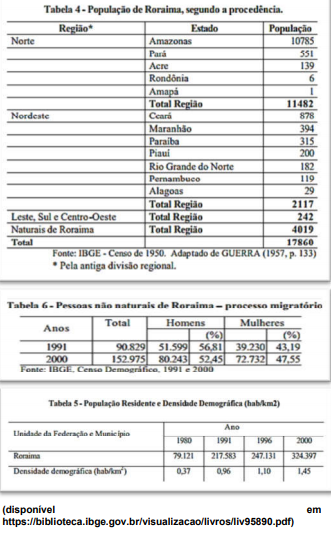TEXT
Roraima also differs from other areas of the
Amazon, given the timid way in which corporate
capital has ventured into the region. Despite its
natural riches, there are no large-scale mining or
timber operations, and local industries are
embryonic. Resulting from the mild stage of
capitalist exploration, and relatively recent human
occupation, the number and intensity of conflicts
over regional resources are substantially smaller.
Migration represented a leading role in the
territorial, political and cultural formation of Roraima.
During the 1970s and 1980s the state received a
considerable influx of migrants from the North and
Northeast regions of Brazil, especially from Ceará,
Maranhão, Pará and Amazonas states. Overtime
migration flows were perpetuated due to the
workings of very active migrant social networks,
linking very specific communities at origins and
destinations. Internally, the city of Boa Vista has
played a paramount role attracting immigrants from
other states and then redistributing them to other
municipalities. The importance of Boa Vista can be
grasped from a quick examination of Roraima's
urban network, where it exerts the role of a primate
city in a highly unbalanced system.
The tremendous influx of migrants over the
1970s and 1980s had a direct impact in the creation of new municipalities, promoting regional
development and economic change, which, in turn,
fueled renewed migratory flows. The 1990s and
2000s witnessed an augmentation of such moves
projecting an inversion in terms of importance of
inter and intrastate moves in future years. After all,
interstate long distance moves have historically
dominated Roraima's migration system;
nonetheless, over the last decades intrastate
migration has grown at a much faster pace than
longer moves.
In the near future Roraima is likely to
continue drawing migrants from traditional areas
given the organic nature of migrant social networks
and its tendency to remain active over time. On the
other hand, new migration flows are likely to arise
and intensify as regional development will create
economic opportunities for many, intensifying formal
and informal communication channels. Within this
context, the service sector, especially the public
administration system will allure urban bound
migrants from various Brazilian cities. However, one
cannot deny the fact that Roraima remains an active
agriculture frontier, where the perspective of
acquiring a free plot of land is still viable. Thus,
Roraima will still receive large waves of landless
peasants in the near future, most likely from
traditional source areas. Nevertheless, in order to
become a valid alternative for the Brazilian poor, it
is imperative that current abandonment rates within
colonization projects are diminished, preventing
them from turning into a demographic void, while
the peripheral areas of the encroaching urban
places become increasingly plagued with poverty.
(Fragment from “The Colonization of Roraima State, Brazil: an Analysis
of its Major Migration Flows (1970 to 2010)”, by Alexandre Magno Alves
Diniz and Elisângela Gonçalves Lacerda, Espace populations sociétés
[Online], 2014/2-3 | 2015, Online since 01 December 2014, connection
on 10 January 2017. URL : http://eps.revues.org/5817 ; DOI :
10.4000/eps.5817)
